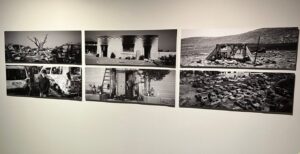Note: This is the fifth article of TC Jewfolk Editor Lonny Goldsmith’s trip to Israel with UpStart and iCenter’s “A Mifgash that Matters,” which is being put on in partnership with The Jewish Education Project and in collaboration with The Jewish Agency for Israel and made possible through support from the Jim Joseph Foundation. Read more: Part 1 | Part 2 | Part 3 | Part 4
TEL AVIV – On Oct. 6, 2023, the work of Danna Wohlfeiler-Lalkin and the jurors that selected the works in the Local Testimony 2023 photojournalism exhibit had been just completed – more than 100 photos detailing life in Israel: the everyday, the tumultuous, and the mundane.
Twenty-four hours later, like so much of Israeli life the past four-plus months, the entire scope of the exhibit was forced to change.
“You cannot show 2023 without the 7th of October,” Wohlfeiler-Lalkin said. “Two weeks had passed and I was working as a cook, preparing meals for soldiers, when the museum called: cultural life should go on.”
Local Testimony 2023 is the 20th anniversary of the exhibit, which photographers in Israel can choose to opt in for consideration. Around 130 photographs by 52 photographers, chosen from 6,700 photographs submitted to the contest – 2,000 images alone from Oct. 7.
“There were difficult, graphic images,” Wohlfeiler-Lalkin said. “We decided we didn’t want graphic images. We don’t have to explain what happened; everyone knows.”
Reopening the contest meant reconfiguring the space at the Eretz Israel Museum.

Photos of the destruction from Israeli settlers in Palestinian territory on display at the Local Testimony 2023 exhibition. (Photo by Lonny Goldsmith/TC Jewfolk).
The first temporary wall in the space shows a 20-minute video slideshow of images from Oct. 7. The other side of that wall shows images of burned-out cars and buildings of Palestinians, destroyed by West Bank settlers. The photos by Oren Ziv of 972 Magazine won the award for Series of the Year for his work.
“The public reaction was emotional,” Wohlfeiler-Lalkin said. “People were angry at some of the images of settler violence. I hope people will see it and be aware of the social complexities. It has a cause and effect. It doesn’t matter your ideology. It’s horrific.”
The exhibit features the last work of Ynet photographer Roee Idan, who shot some of the initial photos of the assault on his home of Kfar Aza, and sent them to his editor before he and his wife were murdered. His daughter Abigail was taken hostage, turned 4 while in captivity, and released on Nov. 26. The newly created Roee Idan Prize was given to an “iconic” photo of the bombed-out Sderot Police Station.
There is plenty of space devoted to the biggest story in Israel before Oct. 7: the protests opposing Prime Minister Benjamin Netanyahu’s judicial reform plan. There are also photos of sports, society and life in Israel.
“Local Testimony is a social event, and social issues are very important issues to us as a curatorial team,” Wohlfeiler-Lalkin said. “The exhibit is complex. It makes you sad, angry, and laugh. But it happened. It makes us move in unease.”













1 comment